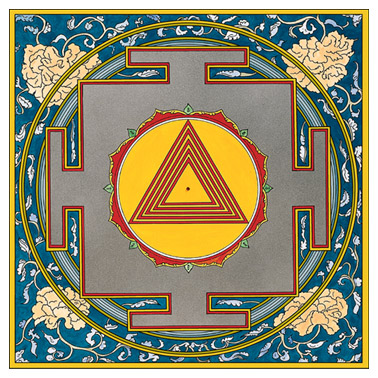
Nagas
I set up a new website at http://www.manasadevi.net/
and I am happy to announce this.
On February 21, 2013,
my necklace of Lord
Ganesh miraculously fell on the ground when I was
leaving my director at my workplace here. I took it up from the ground
and, to my amazement, the silver chain was not
broken, neither was it released. I put the intact
chain over my head back as if nothing happened. The picture
of the chain 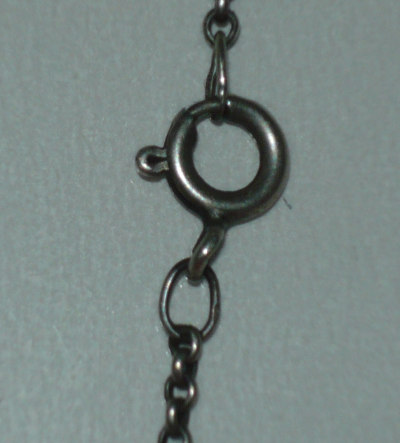 shows
the image on the right. It is
not possible that, as you see on the picture, such a chain would suddenly
fall down on the ground without being broken or without its fixing
mechanism being released. And finding a half-meter white snake (White
Cobra?) trail at my home on the carpet in 2011 is a definite clue
for me that I should continue with my devotion to Manasa and the Nagas,
although I do not belong to the mainstream. Some of my paranormal
experiences are described
here - the above paranormal experience with Lord Ganesh happened
on Jaya Ekadashi. The importance of Jaya Ekadashi was narrated to
Yudhishtira by Lord Krishna and is found
in the Padma Purana and the Bhavisyothara Purana. On this day, both
Lord Vishnu and Lord Shiva are worshipped.
shows
the image on the right. It is
not possible that, as you see on the picture, such a chain would suddenly
fall down on the ground without being broken or without its fixing
mechanism being released. And finding a half-meter white snake (White
Cobra?) trail at my home on the carpet in 2011 is a definite clue
for me that I should continue with my devotion to Manasa and the Nagas,
although I do not belong to the mainstream. Some of my paranormal
experiences are described
here - the above paranormal experience with Lord Ganesh happened
on Jaya Ekadashi. The importance of Jaya Ekadashi was narrated to
Yudhishtira by Lord Krishna and is found
in the Padma Purana and the Bhavisyothara Purana. On this day, both
Lord Vishnu and Lord Shiva are worshipped.
Of the celestial Naga snakes I am Ananta.
(Lord Krishna says in the Bhagavad Gita, Chapter
10, verse 29)
The word "nag"
(or nagaa) is used even today in most Indian languages (it means the
cobra).
Manasa Devi is
worshipped with the following mantra:
O DeviAmba Ma Hona ShashaDharVandana CharuKanti Badanya
Dansarurasundara SulalitNayana Sevita SiddhiKameh
Rupe Rasya Manditandago KanakManiGaneh NagRatneRanekeh
Bandeh Sashtananga Darukuchyugla Bhogini Kamrupa
OR
Om Hreem Shreem Kleem Aim Manasa Devyai Swaha
The Rig Veda Brahmana mentions
"Serpent Queen" - The serpent queen
is this (earth), for this (earth) is the queen of what creeps...The
above text is available at the following link.
Although it is not clear whether
Rig Veda speaks directly of Manasa or not, one thing is sure - the
snake cult is one of the oldest in the world.
Naga is the Sanskrit
word for a deity or a class of mythological beings found in Hinduism
and Buddhism. They dwell in underground
premises of our Earth. There are legends about Nagas in the folklore
of present tribal Hindus of Southern India (Adivasis) and the aboriginals
of Australia. In these legends, the Nagas inhabited a big continent
that existed somewhere in the Pacific Ocean. It sank and the remnants
of it formed the Indonesian archipelago and Australia. These Nagas
are said to have developed a subterranean civilization technologically
much more advanced than ours and they are thought to possess superhuman
powers. In a Cambodian legend, the Nagas were a reptilian race of
beings who possessed a large empire or kingdom in the Pacific Ocean
region. The seven-headed Naga serpents depicted as statues on Cambodian
temples such as Angkor Wat possibly represent the seven races within
the Naga society.
I
made a new version of FreeBSD distribution - MaheshaBSD-2.0. Manasa
Devi, snake Goddess, is its logo.
You may donate to this project.
Nagas are so called "snake people". They
are mentioned in many Hindu texts. Arjuna married a Naga princess
Ulupi (source: Bhagavadgita) and there is also a Tamil text Kanzul
Karamat, which describes one Muslim saint as he was captured and
transported in Sri Lanka's Kataragama to a subterranean palace where
he received a mysterious robe.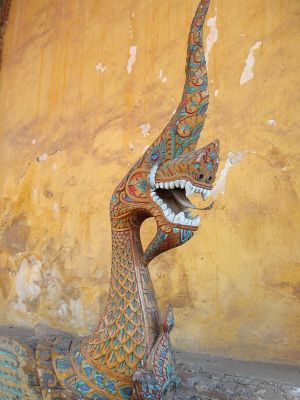
There is a Naga
Purana, or Nilamata Purana,
which has its origin in Kashmir.
The chief of the Nagas is Varuna,
a Vedic god. A female Naga is called Nagini. King of the Nagas is
Vasuki. The difference between Varuna and Vasuki is that Varuna may
not always be necessarily solely associated with all the matters of
the Nagas. Vasuki himself is a serpent and Varuna is not. Vasuki's
sister is Manasa Devi.
In Sanatana Dharma you may also come across a supernatural expansion
of Lord Vishnu called Shesha.
Vishnu once assumed a form of the gigantic divine snake with thousands
of heads.
The underground kingdom (of
the Nagas) describe, for example, the Puranas - one such a story is
related to Lord Vishnu's Vamana,
or "dwarf incarnation", which occurred in Treta Yuga
(the second age) - much earlier than the events described in the
Ramayana. Lord Vishnu appears to king Mahabali. Mahabali
was king of the Indian region (formerly kingdom) presently known as
Kerala (a state in south India bordering with Tamil Nadu),
who
stands behind the most popular legend here - the Onam
legend, which has over many years transformed into the
festival celebrating the return of King Mahabali from the underground
to Kerala every year (it is believed that Mahabali visits Kerala for
a short time to see if his people are doing well). Read
how Lord Vishnu tested this king.
Manasa Devi
Manasa Devi is Hindu cobra (snake) Goddess, Queen
of the Nagas.  She
is believed to be the daughter of Lord Shiva.
The story of Her birth starts when Lord Shiva was sexually aroused
on the banks of the Kalidaha pool, a pond in West Bengal in the town
called Rajnagar. It is dedicated to Goddess Kali. Manasa Devi is associated
with a very rich merchant (Chand
Saudagar). Other stories say that She is the daughter of sage
Kashyapa and Kadru. She is worshipped mainly in Bengal and in northeastern
India, chiefly for the prevention and cure of snakebites, but also
for fertility and prosperity.
She
is believed to be the daughter of Lord Shiva.
The story of Her birth starts when Lord Shiva was sexually aroused
on the banks of the Kalidaha pool, a pond in West Bengal in the town
called Rajnagar. It is dedicated to Goddess Kali. Manasa Devi is associated
with a very rich merchant (Chand
Saudagar). Other stories say that She is the daughter of sage
Kashyapa and Kadru. She is worshipped mainly in Bengal and in northeastern
India, chiefly for the prevention and cure of snakebites, but also
for fertility and prosperity.
The Manasa's vahana (vehicle) is either the swan
or the snake. The Sij plant (Euphorbia
Hguhria called Sehund or Sij in Hindi), of the cactus family,
is sacred to Manasa, as it can cure poisons. Astika, an ancient Hindu
rishi (sage), is the Manasa's son that She
conceived with Jaratkaru.
The Bengali historian Dineshchandra Sen (1866-1939)
brought a few important aspects of the Manasa worship to the notice
in his book entitled History of Bengali Language and Literature.
This excellent book is available for free in the archive.org
archive here.
A
beautiful song dedicated to Manasa Devi.
Neta Devi (and Manasa Devi continued)
Neta Devi is tightly related to Manasa Devi and both
these (snake) goddesses are mentioned in a few Indian Puranas and
in other sources as well. One of the sources (that will point you
to a number of references), too, is the book entitled Myths of
the Hindus & Buddhists by Sister Nivedita. Neta Devi (eye)
and Manasa Devi (moon) are both related
to a woman known as Behula. Behula was an archetypal Bengali woman
full of love. She was the daughter-in-law of Chand
Saudagar (mentioned above) who denied worshiping Manasa Devi.
According to an Indian myth, two beautiful apsaras, Usha and Aniruddha,
were tricked by Manasa Devi and Neta
Devi, and these two apsaras thus went to earth to be born as
mortals - one as the Chand's seventh son Lakhinder and the other one
as his (Lakhinder's) wife Behula. With their tricky plan they (Manasa
and Neta) already made the six Chand's sons die of snakebite (because
he refused to worship them).
Manasa Devi was born out of the Lord
Shiva's semen when Lord Shiva was aroused
to passion and dropped His semen on a lotus flower, Padma in Sanskrit
(however, other sources say that Her father was Kasyapa). Manasa therefore
claimed the same right to be worshiped as Lord
Ganesh and Lord Skanda (Murugan),
but Parvati did not like this. She (Manasa
Devi) therefore had many quarrels with Parvati. Lord Shiva finally
took Manasa Devi to a deserted place and created a companion Neta
for Her from His tears. Thus, Manasa Devi and Neta Devi are sisters
and both are very important.
When Chand finally yielded and started offering a
flower to Manasa with his left hand (and without looking at Her idol
in fear that he would displease Shiva), this
made Manasa Devi so happy that She resurrected all of the Chand's
sons and restored the Chand's fortunes.
The symbol of Manasa Devi is the sun
rising over the half moon, but the half moon with the sun wedged
into the half moon (not separated from it) - the symbol that looks
exactly like an eye (you may see it in temples in India and in other
places where Manasa Devi has Her devotees). Manasa Devi is often called
"the one-eyed goddess", as Parvati
burned one of Her eyes. The Sanskrit word "manasa" is also
tightly related to the word Manasarovar (derived from the two words:
"mana" and "sarovara" - lake, but also the name
Manasa Sarovara is used), the lake at the foot of Mt Kailash, the
holiest mountain of Shaivism, Bön, Jainism, and Buddhism.
I am sorry to say that there is not much information
about Neta Devi. But if you pray to Manasa Devi, I would also suggest
praying to Neta Devi.
Manasa Devi is mentioned in the Puranas and also
in the Manasamangal Kavya - a poem that belongs to Mangal-Kavya, a
group of Bengali (Hindu) religious texts (poems) composed sometimes
after the 12th century and later. Manasamangal Kavya is the oldest
of them. Some texts dedicated to celebration of Manasa Devi are also
taken from the Brahma Vaivarta Purana,
the origin of which is tightly associated with the region of Bengal
(where the worship of Manasa Devi has been in vogue for many years).
The said texts are taken from the second part of the Brahma Vaivarta
Purana called Prakriti khanda, which
deals with goddesses (Shaktis - the manifestations of Prakriti, the
basic nature of intelligence on which the universe stands; Prakriti
khanda celebrates the greatness of Durga, Lakshmi, Saraswati and Savitri
in the creation of the world). These texts are used also for purposes
of celebrating Manasa Devi. During the Manasa puja ceremony people
bath the statues of Manasa Devi with milk and recite the hymns taken
from Prakriti khanda. Poems that people dedicated to Manasa Devi are
known as Manasa Mangal in Bengal.
In Chapter 38 (Book 9) of the Devi Bhagavatam Purana
it is written: "You should worship Manasa
Devi, the giver of all siddhis, on the Samkranti day (when the Sun
enters another sign) in every year;" here I can say that
also this is the reason why the worship of Manasa Devi is based on
the moon calendar. The Naga deities are traditionally associated with
number 5, so worshipping them requires a devotee to dedicate milk/prayer
either on Friday (fifth day of the week), or on the fifth lunar day.
Chapter 48 of the Book 9 (Devi Bhagavatam Purana)
says: "Now the radical mantra as stated
in the Vedas is 'Om Hrim Shrim Klim Aim Manasa
Devyai Svaha'. Repetition of this, five lakhs of times, yields
success to one who repeats."
In the Book 9 of the Devi Bhagavatam Purana, Chapter
1, the following text is written (starting with verse 71): "Then
comes the Manasa Devi, the daughter of Kasyapa. She is the dear disciple
of Shankara (Lord Shiva) and is therefore very learned in matters
of Shastras. She is the daughter of Ananta Deva, the Lord of Snakes
and is very much respected by all the Nagas. She Herself is very beautiful,
the Lady of the Nagas, the mother of the Nagas and is carried by them.
She is decorated with ornaments of the Snakes; She is respected by
the Nagendras (Lords of Snakes) and She sleeps on the bed of Snakes."
In Chapter 48 (Book 9) of the Devi Bhagavatam Purana
it is written: "I meditate on the Devi
Manasa, whose color is fair like that of the white champaka flower,
whose body is decked all over with jewel ornaments, whose clothing
is purified by fire, whose sacred thread is the Nagas (serpents),
who is full of wisdom, who is the foremost of great Jnanins, who is
the presiding deity of the Siddhas, who Herself is a Siddha and who
bestows Siddhis to all."
The Vedas, too, contain a reference to the Nagas
(snakes), for example, the Sama Veda (4.6.13, Sukta 13 - Charm against
Snake Poison) says: "I have surrounded
the race of the serpents."
Nag Panchami
Nag Panchami is a festival for celebration of the
Nagas (both deities and cobras) on the fifth day after Amavasya of
the month of Shraavana (beginning in late July and ending in the third
week of August).
Nagini
Nagini is the word used to call the female counterparts
of deities called "snake deities" in Hinduism.
Khodiyar Maa
The story of Khodiyar Maa
started in around 700 AD and begins
with a childless man - Mamaniya Gadhvi, who had a superb relationship
with the then ruler - Maharaj Shilbhadra. The ruler's ministers
envied this exceptional relationship and prepared a way to get rid
of Mamaniya Gadhvi. They were not very successful to persuade
the ruler, but they succeeded in persuading the ruler's wife (queen).
One day the ruler's doorkeepers did not allow him to enter the palace.
Mamaniya asked why. He was told that a childless man is not worth
of the king's presence. 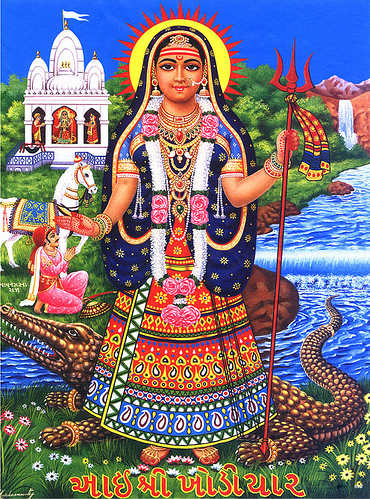 Mamaniya
returned home and asked Lord Shiva
for help. When Lord Shiva did
not appear, he decided to give his life away as a final sacrifice.
Just when he was about to end his life, Lord
Shiva appeared and took him
to the Snake Kingdom - Naglok
(or Naga Loka) to see the King of Snakes
- Nagdev. After hearing his story full of humiliation,
the Nagdev's daughters decided to help him.
Mamaniya
returned home and asked Lord Shiva
for help. When Lord Shiva did
not appear, he decided to give his life away as a final sacrifice.
Just when he was about to end his life, Lord
Shiva appeared and took him
to the Snake Kingdom - Naglok
(or Naga Loka) to see the King of Snakes
- Nagdev. After hearing his story full of humiliation,
the Nagdev's daughters decided to help him.
The picture of Khodiyar Maa
is copyrighted and taken from http://www.flickr.com
(search for the key word "Khodiyar Maa"
to see more pics).
When Mamaniya returned home, together with
his wife, as advised by the Nagdev's daughters, he
prepared eight cradles in
expectation of a great event. One day eight snakes crawled
into his house and Mamaniya had suddenly
seven daughters and one son.
One of the daughters was Khodiyar Maa. After showing many miraculous
powers, people consider her to be goddess and she has temples and
shrines too. Her vehicle is crocodile and she has many other
names such as Khodal, Trishuldhari, Maavdi...
Vasuki
Vasuki is King of the Nagas. Manasa and Neta are
his two sisters.
Colors, numbers, mantras, and symbols
Eight (8) is the token number of Naga.
The color of Manasa and Neta is pearl white; that of Taksaka is glistening
red. Nagas have five colors: 1)
white (Vasuki, Mahapadma, Manasa, Neta), 2)
red (Taksaka, Kulika), 3) black
(Karkotaka), 4) rosy color of
the lotus (Padma), 5) yellow,
it is the Sankhapala's color.
According to Indian astrology, the God of the fifth
date is snake. This is why the number 5 is very important for the
Nagas, but also for Lord Shiva. Nagas are therefore
considered to be the Lord Shiva's gems.
To summon the Serpent Lord, chant the following mantras:
Om Nagadevathaya Vidhmahe
Jwala Malaya Dhimahi
Tanno Ananda Prachodayat
The mantras for the eight (8) snake power jewels
are (the vowels like "aa" are pronounced with accent like
in the English word "are")
Om Puuh Anantamukhii Swaahaa
Om Puuh Karkodamukhii Swaahaa
Om Puuh Padminii Swaahaa (Padmavati)
Om KaalaJiihvaa Puuh Swaahaa
Om Mahaapadminii Swaahaa
Om Vaasukiimukhii Swaahaa
Om Hum Hum Puurvabhuupamukhii Swaahaa
Om Shankhni Vaayumukhii Hum Hum
Nagarajas and Naginis in Hindu and non-Hindu
mythologies in a more concise focus (for people who have more time)
Does the underworld really exist?
1)
In the middle of the last century an American ufologist George Wight
tried to explore the caves and underground realms of our Earth. He
believed that there are not only civilizations in the universe, but
also bellow our surface. With a little
group of enthusiasts he started exploring various caverns until they
finally found something really amazing under the surface in the US
state of Arkansas. George Wight got into contact with this subterranean
civilization and later all evidence and records of him ever existing
in the upper world (on the surface) began to mysteriously disappear.
2)
In Slovakia we have a captivating story about a mysterious moon
shaft that Antonin Horak described. His article first appeared
in a speleological newsletter in USA (in March 1965) where he emigrated
after World War II. Mr. Horak had joined the local (Czechoslovak)
anti-Nazi movement in World War II and when German soldiers wounded
him on one unfortunate day, he hid himself in a nearby village where
a man took him into a cave near Zdiar. Mr. Horak spotted there a rock-cut
(nearly) vertical tunnel of a crescent-moon shape with no ending.
Jacques Bergier, a famous French mystery writer, described the Horak's
finding as one of the biggest miracles waiting for its discovery.
3)
A famous British explorer, Percy
Fawcett, reported that in the Brazilian jungle of the Matto Grosso
region there had been noticed "eternal lights", which -
as the local Indians say - have burnt continually here for many years.
Percy Fawcett was a proponent of the mythological Atlantis and he
disappeared here. Some people say that he went into this subterranean
world.
4)
Admiral Richard Evelyn Byrd, Jr., was a famous US naval officer and
his secret diary reveals notes on entering the hollow earth interior:
We have let you enter here because you are of noble character and
well-known on the Surface World, Admiral. His diary also contains
notes on seeing UFO's with swastikas on them: They
are closing rapidly alongside! They are disc-shaped and have a radiant
quality to them. They are close enough now to see the markings on
them. It is a type of Swastika!!!
Nagas (also called Sarpas) and Agartha in the Hindu mythology
Lord Shiva always wears cobras
as decoration around His neck.
Snakes symbolize power and fear. The theriomorphic (human-animal)
forms of Nagas can be traced back to the times of the Indus Valley
civilization (2500-1800 B.C.). Nagas are almost always associated
with Lord Shiva and therefore most of
their images are found inside Shiva temples. The snake worship (ophiolatry)
is an ancient cult that has been practiced all over the world and
not only by the Indians. Naga is a Sanskrit
word for cobra. In the Hindu mythology,
the venom of a Naga or Nagini, albeit deadly, also carries the elixir
of immortality.
The Agni Purana says (Part 8, Geography, Astrology and Time
Cycles): "Under the earth is the underworld. This too, consists
of seven regions and their names are Aata, Vilata, Sutala, Taketala,
Mahatala, Rasatala and Patala."
The Supreme Naga is Shesha, the
couch of Lord Vishnu; also known as Ananta,
he represents the eternity.
The Mahabharata mentions Nagas as sons
of Kadru and Kasyapa. Only the parenthood of Manasa (Queen of Cobras)
is disputable. Some stories say that She was the daughter of Lord
Shiva.
Nilamata Purana is a Naga Purana dedicated to the region of Kashmir.
Nila, King of the Nagas of Kashmir, is described here.
Mayashilpa (an ancient text, part of Shilpa
Shastras, a group of Hindu texts describing manual arts) specifies
the Seven Great Nagas: Vasuki (sometimes also spelled as Basaki),
Takshak, Karkotak, Padam (also spelled as Padma), Mahapadam (also
spelled as Mahapadma), Sankhpaul (also spelled as Sankhapala), and
Kulika.
The Hindus know the Hollow Earth or Agartha as Patala. In the Markandeya
Purana (Canto XXIII - Kuvalayasva's visit to Patala) it is written:
"And drawing him thence, they led the prince to Patala; and in
Patala he beheld them both as young Nagas, lustrous with the gems
in their hoods, displaying the svastika marks."
Five most important Nagas
All Great (Maha) Nagas are brothers, Shesha being the eldest of them.
Ananta or Shesha is King of all Nagas; according to the Bhagavata
Purana, he is the very Avatar of Supreme God.
Vasuki is the ardent devotee of Lord Shiva and one of the Naga Rajas
(Kings of Nagas).
Takshaka or Taxak is mentioned in the Mahabharata (Book 1, Adi Parva,
Paushya Parva, Section III.): "Uttanka replied, 'Sir, Taksaka,
the Naga king, disturbed my work, and I had to go to the land of the
Nagas.'"
Karkotaka is a powerful Naga king with immense magical powers.
Pingala is related to a mythological story of "Four Great Treasures".
Eight most important Nagas
Hindu Puranas also describe "eight great snakes" or "Ashtanagas";
the following three Nagas, if added to the above-mentioned list, will
make the number eight: Padma, Mahapadma, and Kulika.
Mother Goddess as Snake
Karumariamman, depicted with a
five-headed cobra rising above Her crown, is the main south
Indian Mother Goddess worshipped predominantly in rural areas of south
Asia. She is not a Nagini (a female Naga), but the primordial form
of Durga (Mother Divine) that took Her first form as a cobra. Also
known as Mari, Maariamma, Amman, she is closely associated with the
Hindu goddesses Parvati (Durga). Striking is the phonetic resemblance
of Her name Mari to Christian Mary (the mother of Jesus).
Surasa and Naga Mata are alternative names for Snake Mother (Mother
Goddess in the form of a cobra).
Hindu Snake Festivals
Nag Panchami is a snake festival celebrated once a year by the Hindus
(in the summer). The following five Nagas are worshipped on this auspicious
day: Ananta, Vasuki, Taxak, Karkotaka, and Pingala.
However, the Hindus may choose other Naga deities in place of the
above ones in accordance with their local traditions (for example,
Manasa appears among the Nagas worshipped on Nag Panchami).
Naga Chaturthi Osha is a fasting observed by women in Orissa (a state
in India) on the 14th day of the bright fortnight of Kartik
(September-October).
Other Nagas
The term Nagas also refers to a historical
warrior caste of India and some scholars say that this caste
used cobra hoods as part of their attire.
Gogaji is a folk deity of Rajasthan (India). He is a warrior-hero
of the region venerated as snake god.
Iggutappa, god of snakes, is an incarnation of Lord
Subramani (Lord Murugan-Skanda, the younger
son of Lord Shiva).
Kaliya was a poisonous and angry Naga living in the Yamuna River.
Ketu is the body of Rahu; they form a head and a tail of one Naga.
Naagarajavu (god of snakes) is adored in Chenkara, a small village
in Alappuzha, India.
Nagaraja is a combination of two Sanskrit words - Naga (cobra) and
Raja (king). A few great Nagas are Nagarajas - for example, Vasuki,
Takshak, and Ananta. The term Nagaraja also refers collectively
to all these three snake gods.
Naka tampiran is a common snake deity in many south Indian villages.
Sri Kalahasti represents the three staunch devotees of Lord Shiva:
the Spider, the Serpent, and the Elephant.
Asvasena Naga was the son of Takshaka; he lived in the Khandava Forest
(an ancient forest mentioned in the epic
Mahabharata).
Naginis (female Nagas)
Kadru was the Hindu ancestral Mother of snakes who had a sister Vinata.
She is also called the one-eyed goddess
like Manasa. She is Sarpamatar, or "Mother of Serpents."
Both Kadru and Manasa have sisters and both also have the name "one-eyed
goddess" (see Manasa bellow to learn why the term "one-eyed"
is used for this deity).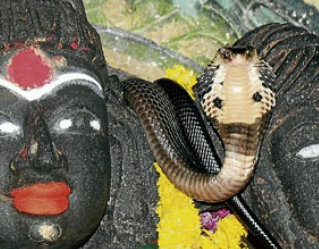
Manasa, also known as Padmavati (the one that possesses the lotus)
or Vishahara (the destroyer of poison), is Hindu Queen of the underworld
(analogical to Greek goddess Persephone).
She is the sister of Vasuki. Manasa is called the "one-eyed"
goddess because Parvati burned one of Her
eyes. The reason for doing this was that Parvati
was jealous of Manasa.
Neta Devi is the Manasa Devi's sister.
More information about the picture on the right is
here.
Ulupi, Naga princess, was the Arjuna's
wife; they had a son Iravat.
Pearls of Nagas
Naga Mani is a term used for "cobra pearls"; they appear
in many colors and have also references within sacred Hindu texts.
Some of them, especially in the night, radiate a magic effulgence.
Snakes in mythologies outside India
Snakes were regularly regarded as guardians of the underworld,
the messengers between the upper and lower worlds. The Gorgons in
the Greek mythology were snake-women whose gaze would turn flesh into
stone; the most famous of them was Medusa (with snakes in place of
her hair).
America
Ayida-Weddo is a Haitian rainbow snake goddess.
Gukumatz (Kiche Maya) is a feathered snake god and creator.
Kukulkan ("Feathered Serpent") is the name of an important
South American snake deity. The depiction of a feathered serpent divinity
is present in other cultures of Mesoamerica. Kukulkan is closely related
to Gukumatz of the Kiche Maya and to Quetzalcoatl of the Aztecs.
Zombi is the name of a snake deity in some cults of West African
Vodun and Haitian Voodoo.
Japan
Mizuchi is a Japanese serpent-like creature.
Yato-no-kami are snake deities in the Japanese folklore.
China
Bashe is a python-like Chinese mythological giant snake that ate
elephants.
Gong Gong is a Chinese water god (a sea monster) that resembles a
serpent or dragon.
White Snake is a serpent referred to in an old Chinese legend.
Xiangliu is a nine-headed snake monster in the Chinese mythology.
Zhulong is a giant red draconic solar deity in the Chinese mythology.
It had a human face and a snake body.
Africa
Mamlambo is a deity in the South African and Zulu mythology described
as a large snake-like creature. Mamlambo in Zimbabwe can be identified
with Inyaminyami (the Zambezi river serpent deity) and with the Mamiwata
deity of West Africa. There is a theory acknowledged by researches
that India and Zimbabwe had long ties and that Tantrism could be practiced
in Mumbahuru, the "Great Enclosure" ("the house of
the great woman"); archeologists found objects of the Indian
origin here.
Ancient Europe
Lamia was a Naga-like daemon in the Greek mythology.
Persephone, the daughter of Zeus and Queen
of the underworld, was a Greek underworld deity; she is the Greek
equivalent of the Hindu snake goddess Manasa.
Sirona was a goddess worshipped predominantly in East Central Gaul
(a region in Western Europe) in the Celtic mythology. A number of
inscriptions depict her as she carries snakes.
Australian aboriginal mythology
Snake deities are: Ungud, Galeru (or Galaru), a rainbow snake; Dhakhan
is described as a giant serpent with the tail of a giant fish; Wollunqua
(or Wollunka, Wollunkua) is a snake-god of rain and fertility; Julunggul
(Arnhem Land) is a rainbow and fertility snake goddess also known
as Kalseru; Akurra is a snake deity of the Aboriginal people of South
Australia.
Egypt
Mehen, meaning "the coiled one", refers to a mythological
snake deity of ancient Egypt.
Wadjet was an Egyptian snake goddess.
Conclusion
Christians associate snakes with Devil only and it could be that,
in our primordial history, snakes did really exist as intelligent
creatures, both good and bad. The following verses from the Bible
(John 3:14-15) confirm that snake is the symbol of power: And
as Moses lifted up the bronze snake on a pole in the wilderness, so
the Son of Man must be lifted up, so that everyone who believes in
Him will have eternal life.
Back
